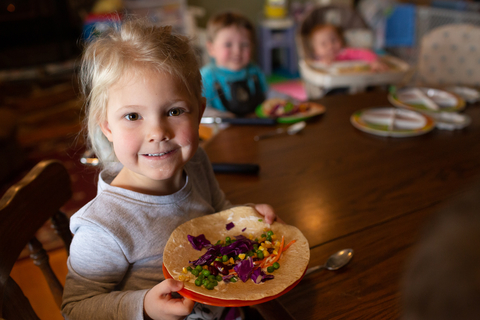University of Minnesota Extension helps Minnesota’s child care providers make meals and snack time yummy, nutritious and affordable
For the dozen or so children who come to Nancy Anderson’s home in Springfield, Minn. for child care, warmer weather means time in the vegetable garden. And the MyPlate nutritional program, which makes learning about healthy food fun, is a frequent fixture in the Brown County home.
Anderson is one of more than 200 Greater Minnesota child care providers who have taken University of Minnesota Extension child care nutrition courses, which are a part of the Supplemental Nutrition Assistance Program Education (SNAP-Ed). Participants learn about the dual goals of good nutrition and providing healthy meals at lower costs.
That matters deeply in Greater Minnesota, where the demand for child care outstrips the supply. “We’re focused on healthy foods and how to help providers save time and money. That can help make a difference and keep them in child care,” says Extension nutrition educator Mary Schroeder. Extension began offering courses, both in person and online, six years ago, starting with a class on the benefits of whole grains.
The quiet crisis
The Center for Rural Policy and Development first called Greater Minnesota’s child care shortage “the quiet crisis.”
In Greater Minnesota, nearly two-thirds of child care is provided within family homes. In 2017, the Legislature reported more than 3,000 family child care providers—nearly 30 percent of the total—left the market between 2005 and 2014. State analysts estimate that translated to a loss of about 36,500 available childcare spaces.
When child care is in short supply, families, employers and communities are hit hard. Families lose wages; businesses lose income and the option to grow.
Better eating, better experience
For Anderson, a child care provider of 25 years, Extension’s nutrition programming offered practical benefits in meal preparation. Schroeder notes many providers view themselves as part of their business community and want to support local grocers and other vendors. “They might get cheaper prices in other towns but they want to stay local when they’re buying food. Our program shows them ways to stretch a dollar and be nutritious and appeal to preschoolers,” Schroeder said.
Extension researches outcomes of the child care nutrition program. One of the most promising developments is the improvement in how providers view themselves as role models of healthy eating, Schroeder says. After one set of courses was complete, only one participant reported no improvement in setting an example, down from nearly 20 when the class began.
For the 3- to 5-year-olds in Anderson’s care, the effect of her participation in Extension’s program also debunked the notion that preschoolers don’t get enthusiastic about eating healthy foods. Using MyPlate materials to help them understand the value of vegetables and fruit made all the difference, Anderson says.
“MyPlate was just huge. We spend the entire summer working on it and the kids loved it,” Anderson says. “And they remember it.”
SNAP-Ed is the educational component of the United States Department of Agriculture’s Supplemental Nutrition Assistance Program, a program that offers nutrition assistance to eligible, low-income individuals and families.



